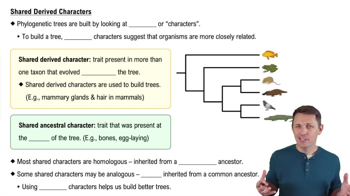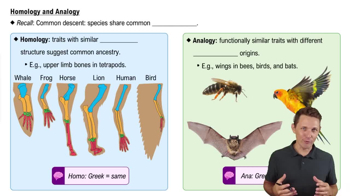Table of contents
- 1. Introduction to Biology2h 42m
- 2. Chemistry3h 40m
- 3. Water1h 26m
- 4. Biomolecules2h 23m
- 5. Cell Components2h 26m
- 6. The Membrane2h 31m
- 7. Energy and Metabolism2h 0m
- 8. Respiration2h 40m
- 9. Photosynthesis2h 49m
- 10. Cell Signaling59m
- 11. Cell Division2h 47m
- 12. Meiosis2h 0m
- 13. Mendelian Genetics4h 44m
- Introduction to Mendel's Experiments7m
- Genotype vs. Phenotype17m
- Punnett Squares13m
- Mendel's Experiments26m
- Mendel's Laws18m
- Monohybrid Crosses19m
- Test Crosses14m
- Dihybrid Crosses20m
- Punnett Square Probability26m
- Incomplete Dominance vs. Codominance20m
- Epistasis7m
- Non-Mendelian Genetics12m
- Pedigrees6m
- Autosomal Inheritance21m
- Sex-Linked Inheritance43m
- X-Inactivation9m
- 14. DNA Synthesis2h 27m
- 15. Gene Expression3h 20m
- 16. Regulation of Expression3h 31m
- Introduction to Regulation of Gene Expression13m
- Prokaryotic Gene Regulation via Operons27m
- The Lac Operon21m
- Glucose's Impact on Lac Operon25m
- The Trp Operon20m
- Review of the Lac Operon & Trp Operon11m
- Introduction to Eukaryotic Gene Regulation9m
- Eukaryotic Chromatin Modifications16m
- Eukaryotic Transcriptional Control22m
- Eukaryotic Post-Transcriptional Regulation28m
- Eukaryotic Post-Translational Regulation13m
- 17. Viruses37m
- 18. Biotechnology2h 58m
- 19. Genomics17m
- 20. Development1h 5m
- 21. Evolution3h 1m
- 22. Evolution of Populations3h 53m
- 23. Speciation1h 37m
- 24. History of Life on Earth2h 6m
- 25. Phylogeny2h 31m
- 26. Prokaryotes4h 59m
- 27. Protists1h 12m
- 28. Plants1h 22m
- 29. Fungi36m
- 30. Overview of Animals34m
- 31. Invertebrates1h 2m
- 32. Vertebrates50m
- 33. Plant Anatomy1h 3m
- 34. Vascular Plant Transport1h 2m
- 35. Soil37m
- 36. Plant Reproduction47m
- 37. Plant Sensation and Response1h 9m
- 38. Animal Form and Function1h 19m
- 39. Digestive System1h 10m
- 40. Circulatory System1h 49m
- 41. Immune System1h 12m
- 42. Osmoregulation and Excretion50m
- 43. Endocrine System1h 4m
- 44. Animal Reproduction1h 2m
- 45. Nervous System1h 55m
- 46. Sensory Systems46m
- 47. Muscle Systems23m
- 48. Ecology3h 11m
- Introduction to Ecology20m
- Biogeography14m
- Earth's Climate Patterns50m
- Introduction to Terrestrial Biomes10m
- Terrestrial Biomes: Near Equator13m
- Terrestrial Biomes: Temperate Regions10m
- Terrestrial Biomes: Northern Regions15m
- Introduction to Aquatic Biomes27m
- Freshwater Aquatic Biomes14m
- Marine Aquatic Biomes13m
- 49. Animal Behavior28m
- 50. Population Ecology3h 41m
- Introduction to Population Ecology28m
- Population Sampling Methods23m
- Life History12m
- Population Demography17m
- Factors Limiting Population Growth14m
- Introduction to Population Growth Models22m
- Linear Population Growth6m
- Exponential Population Growth29m
- Logistic Population Growth32m
- r/K Selection10m
- The Human Population22m
- 51. Community Ecology2h 46m
- Introduction to Community Ecology2m
- Introduction to Community Interactions9m
- Community Interactions: Competition (-/-)38m
- Community Interactions: Exploitation (+/-)23m
- Community Interactions: Mutualism (+/+) & Commensalism (+/0)9m
- Community Structure35m
- Community Dynamics26m
- Geographic Impact on Communities21m
- 52. Ecosystems2h 36m
- 53. Conservation Biology24m
25. Phylogeny
Phylogeny
Problem 1
Textbook Question
In a comparison of birds and mammals, the condition of having four limbs is
a. A shared ancestral character
b. A shared derived character
c. A character useful for distinguishing birds from mammals
d. An example of analogy rather than homology
 Verified step by step guidance
Verified step by step guidance1
Understand the terms: A 'shared ancestral character' is a trait that originated in an ancestor of the taxon and is present in all its descendants. A 'shared derived character' is a trait that is present in an organism but was absent in the last common ancestor of the group being considered.
Consider the evolutionary history of vertebrates: Both birds and mammals are tetrapods, meaning they have four limbs. This trait originated in a common ancestor of all tetrapods, which includes amphibians, reptiles, birds, and mammals.
Determine if the trait is ancestral or derived: Since the condition of having four limbs is present in the common ancestor of birds and mammals and is found in other groups like reptiles and amphibians, it is considered a shared ancestral character.
Evaluate the options: Option a describes a shared ancestral character, which fits the condition of having four limbs in both birds and mammals. Option b refers to a derived character, which is not applicable here as the trait is ancestral. Option c is incorrect because having four limbs does not distinguish birds from mammals. Option d is incorrect because the trait is homologous, not analogous.
Conclude the analysis: Based on the understanding of shared ancestral characters and the evolutionary history of tetrapods, the correct answer is that having four limbs is a shared ancestral character (option a).
 Verified video answer for a similar problem:
Verified video answer for a similar problem:This video solution was recommended by our tutors as helpful for the problem above
Video duration:
54sPlay a video:
Was this helpful?
Key Concepts
Here are the essential concepts you must grasp in order to answer the question correctly.
Shared Ancestral Character
A shared ancestral character, also known as a plesiomorphy, is a trait that is present in an ancestor and all of its descendants. In the context of birds and mammals, having four limbs is a shared ancestral character because this trait was present in their common ancestor and has been inherited by both groups.
Recommended video:

Shared Derived Characters
Shared Derived Character
A shared derived character, or synapomorphy, is a trait that is present in an ancestor and shared exclusively by its evolutionary descendants. It is used to define a clade. In this question, the condition of having four limbs is not a shared derived character for birds and mammals, as it is not unique to these groups but rather inherited from a distant common ancestor.
Recommended video:

Shared Derived Characters
Analogy vs. Homology
Analogy refers to similarities between organisms due to convergent evolution, not common ancestry, while homology refers to similarities due to shared ancestry. The condition of having four limbs in birds and mammals is an example of homology, not analogy, as it is derived from a common ancestor, rather than being independently evolved in each group.
Recommended video:

Homology and Analogy

 7:10m
7:10mWatch next
Master Reading a Phylogenetic Tree with a bite sized video explanation from Jason
Start learningRelated Videos
Related Practice
Multiple Choice
Paralogous genes __________.
1333
views
